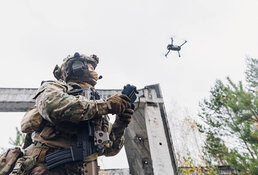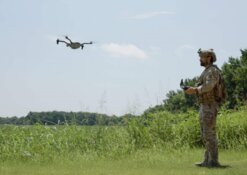According to a May report from Market Research Future, the global military drone market was valued at US$13.42 billion in 2023 and was projected to reach US$30.5 billion by 2035. This growth reflected a compound annual growth rate (CAGR) of 7.09% from 2025 to 2035. Market Research Future identified defense, homeland security, and research and development as the key end-use segments contributing to this trajectory, with significant investment driven by rising defense budgets and an increasing need for advanced surveillance, reconnaissance, and combat capabilities.
The report highlighted that surveillance applications alone were expected to rise from US$5.0 billion in 2024 to US$10.5 billion by 2035. Combat drone applications were projected to increase from US$3.5 billion to US$7.2 billion over the same period, while logistics and reconnaissance roles were also expected to see significant growth.
According to Market Research Future, "Purchasing cutting-edge unmanned aerial vehicles (UAVs) is a top priority for governments in an effort to enhance military operations, surveillance, and reconnaissance."
This investment also extended to technological partnerships. Market Research Future noted increased collaboration between defense organizations and technology companies as a contributing factor to more autonomous and efficient drone systems. These included drones incorporating artificial intelligence (AI) and machine learning to perform independent battlefield tasks, such as route optimization, threat identification, and precision targeting.
Counter-Drone Technologies and Homeland Defense
In a report published on October 13 by The Washington Times, the urgency of building cost-effective counter-drone tools was outlined as a major concern for the U.S. military and law enforcement. The piece focused on the U.S. Army's efforts to upgrade its sensor capabilities, including the integration of Teledyne FLIR's SkyRaider drone with the MUVE B330 payload into the Stryker reconnaissance vehicle system under a five-year, US$168.3 million contract.
Officials cited the increasing use of inexpensive tactical drones by hostile actors as a galvanizing threat. "The wide breadth of this threat requires a no one-size-fits-all approach," said Maj. Gen. David Stewart of the U.S. Army during a panel discussion at the Association of the U.S. Army (AUSA) conference.
Multiple technologies were on display during the AUSA event, including Honeywell's SAMURAI system, which can track and intercept up to 400 drones using radar, cameras, and electronic warfare. Tom Konicki of Honeywell Aerospace Technologies said, "Drones are very much a part of warfare today. But it's not just warfare . . . Everybody is having this problem." His comments emphasized the dual-use nature of drones across both military and domestic security applications.
The article also outlined concerns from lawmakers about the risk drones pose at high-profile public events, prompting increased attention toward directed energy weapons and rifle-mounted systems such as Israel Weapons Industries' ARBEL. This highlighted the broader industry shift toward cost-effective, modular, and scalable anti-drone capabilities.
Global Context and Industry Response
On September 30, Financial News Media reported that technological advances in avionics and precision-guided munitions were critical to the growth of the international drone market. Citing Markets and Markets, the report stated that the military drone sector was projected to grow from US$15.80 billion in 2025 to US$22.81 billion by 2030, at a CAGR of 7.6%.
According to Markets and Markets, "Breakthroughs in avionics, sensors, communication, AI integration in drones have massively boosted the capabilities of these drones." The use of drones equipped with high-resolution surveillance cameras and improved navigation systems enabled more effective and targeted combat operations, reinforcing the sector's strategic importance to modern militaries.
The Financial News Media report also emphasized increased investment in research and development from both major defense contractors and startups. It attributed North America's dominant market share to the presence of leading UAV manufacturers and strong defense budgets, particularly in the U.S.
Also on September 30, NPR reported from Lviv, Ukraine, where the country's growing domestic drone industry was on display. Ukrainian companies like FRDM Group showcased drones ranging from single-use explosive units to reusable strike drones. Maksym Yakovlev of FRDM Group described a model that could carry 30 pounds of weaponry and return after deployment, selling in pairs for under US$70,000.
Ukraine, which had no significant drone industry before Russia's 2022 invasion, was expected to produce over four million drones in 2025. Yaroslav Azhnyuk, a former Silicon Valley entrepreneur, said, "Ukraine today is the defense valley of the world," reflecting how necessity had fueled innovation. NPR noted that some Ukrainian drones had been used to strike oil infrastructure deep inside Russian territory, underscoring their operational significance.
Ukrainian officials indicated that the country now produced nearly 40% of its own weapons and was developing long-range systems like the Flamingo cruise missile, capable of traveling 1,800 miles.
Commercial Expansion and Broader Applications
Earlier, in the summer, a report from Nasdaq described the global drone market as undergoing expansion beyond military uses into sectors such as agriculture, logistics, and infrastructure inspection. In China alone, more than 2.2 million drones were registered, with the country forecasting a "low-altitude economy" valued at US$490 billion by 2035.
The Nasdaq article reported that U.S. policy and favorable regulatory environments had contributed to a surge in commercial drone activity. Companies with diversified portfolios spanning military and civilian use cases were considered well-positioned. The report cited advances in 5G, LiDAR, and autonomous flight systems as key enablers of growth. AeroVironment, AIRO Group, and Kratos Defense were named as notable performers in 2025, reflecting growing investor interest in the sector.
Important Disclosures:
- Unusual Machines is a billboard sponsor of Streetwise Reports and pays SWR a monthly sponsorship fee between US$3,000 and US$6,000.
- As of the date of this article, officers and/or employees of Streetwise Reports LLC (including members of their household) own securities of Unusual Machines and Red Cat Holdings.
- James Guttman wrote this article for Streetwise Reports LLC and provides services to Streetwise Reports as an employee.
- This article does not constitute investment advice and is not a solicitation for any investment. Streetwise Reports does not render general or specific investment advice and the information on Streetwise Reports should not be considered a recommendation to buy or sell any security. Each reader is encouraged to consult with his or her personal financial adviser and perform their own comprehensive investment research. By opening this page, each reader accepts and agrees to Streetwise Reports' terms of use and full legal disclaimer. Streetwise Reports does not endorse or recommend the business, products, services or securities of any company.
For additional disclosures, please click here.











































